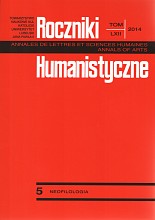The Enigma Explained: The Study of the Chronotopic Relation between V. S. Naipaul’s Novel The Enigma of Arrival and Giorgio de Chirico’s Painting...
The Enigma Explained: The Study of the Chronotopic Relation between V. S. Naipaul’s Novel The Enigma of Arrival and Giorgio de Chirico’s Painting...
Author(s): Magdalena SawaSubject(s): Literary Texts
Published by: Towarzystwo Naukowe KUL & Katolicki Uniwersytet Lubelski Jana Pawła II
Keywords: ekfraza; chronotop; V. S. Naipaul; Giorgio de Chirico; czas i przestrzeń w literaturze i sztuce
Summary/Abstract: The Enigma Explained: The Study of the Chronotopic Relation between V. S. Naipaul’s Novel The Enigma of Arrival and Giorgio de Chirico’s Painting The Enigma of Arrival and the Afternoon Abstract.The article is a comparative analysis of V. S. Naipaul’s novel The Enigma of Arrival and Giorgio de Chirico’s painting The Enigma of Arrival and the Afternoon. The relation between those two works extends far beyond the title. The novel and the painting seem to inform each other so that the book can be seen as an extended ekphrastic response to the image or the visual scene can be read as mise-en-abyme of the entire novel. The common denominator for the interaction of the visual and verbal Enigma is the idea of the chronotope. All the major elements of the image, i.e. the internal hesitation symbolically represented, the city square in the background, the idea of uncertainty and indefiniteness suggested by the motif of voyage, as well as the interconnectedness of the past and the present in the architecture of buildings, involve de Chirico’s Enigma in a peculiar relationship with literature and Naipaul’s novel in particular. In the context of the novel, the painting becomes an exact representation of the chronotope of the threshold in the narrator’s life, when first in New York and then in London the breach in his personality becomes recognised and begins to determine all his subsequent decisions and actions. Consequently, Bakhtin’s words referring to the representational potential of the chronotope become literally materialised and concretised in de Chirico’s painting. Moreover, the close interaction of Naipaul’s novel and de Chirico’s painting, as discussed in this study, is accompanied by the process of approximating the condition of the other art.
Journal: Roczniki Humanistyczne
- Issue Year: 62/2014
- Issue No: 05
- Page Range: 245-259
- Page Count: 15
- Language: English

